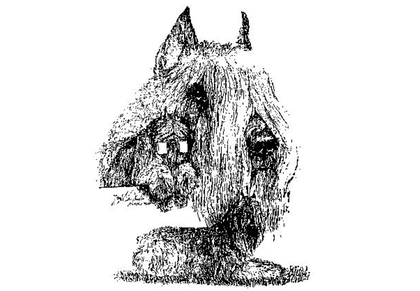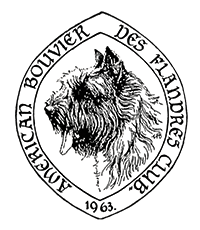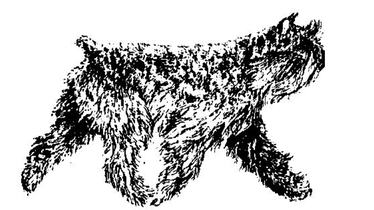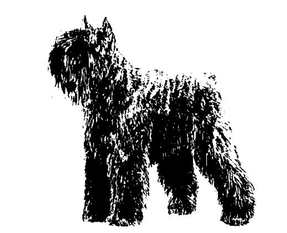Beginner's Guide to the Bouvier
Latest edition written and compiled by Kitty Korth for the ABdFC
Introduction

Have you asked yourself why you want a Bouvier? First and foremost, the Bouvier is a herding dog that possesses certain inherited instincts. It will be the owner's responsibility to channel these traits positively.
The Bouvier -- a versatile, intelligent and agile breed -- is not a dog for everyone. By virtue of its size and strength, it is essential that the owner be capable of providing the dog with kind and consistent training. This article is part of a series being offered in the hopes that this information will clarify for you whether indeed this is the right breed for you. If, in fact, you are inspired more than ever to experience Bouvier love, then these articles will guide you toward a positive, fun-filled and rewarding life together. For the right family the Bouvier can be the companion of a lifetime. |
Articles in this Series- Beginners Guide to the Bouvier des Flandres - How to Select a Breeder - What About a Rescue Dog? - How to Read a Pedigree - Selecting Your Bouvier Puppy Lyn St Clair artwork, courtesy of and sole property of Kathleen Kane. |
History of the Bouvier des Flandres
|
Origin: Belgium
In the late nineteenth century, a program of selective breeding, that would eventually produce the dog we know today as the Bouvier, was begun in the farming regions of Belgium. Documentation of his ancestry is cloudy, but his beginnings are loosely attributed to a type of sheepdog (berger), the Dutch griffon, and the barbet, or water dog. By 1910, specific interest in this tousled-coated herder and protector grew as far as the cattle areas near the River Lys Valley. At that time, Bouviers were being used as drovers, draft animals, activators for churning mills, and farm and family protectors. Common characteristics were bobtails, cropped ears, a harsh tousled coat, and perfect instincts for guarding his flock, home and family. In those days, tails and ears were routinely shortened because they were easy targets for farm predators. The first "standard" for the Bouvier des Flandres was developed in 1912. Then, during W.W.I (and later, W.W.II), as the home territory of the Bouvier des Flandres became a battlefield, their numbers were drastically cut – almost to extinction. Those who stayed worked as ambulance litter-pullers and military tracking aides. Only a few escaped to other countries. Those who survived, some taken to France and the Netherlands, became part of discriminating breeding programs for a particular type. The Club National Belge du Bouvier des Flandres, formed in Gent early in 1922, formulated specific qualities of type for future breeding. The Bouvier came to America in the late 1920's, and now extends throughout the US and Canada. The legacy of the Bouvier has produced many admirable qualities in this breed. He is a square, powerfully built dog, rugged and formidable in appearance. His harsh double coat protects him in all types of weather; his keen sense of smell and watchful gaze make him a most suitable farm dog. (He thrives on plenty of room to work and exercise, but he is not an "outdoor dog"; he must live with his loving people -- his "flock," his "pack".) He is agile, alert and intelligent, with character of great spirit and fearlessness; yet, he is serene in disposition, and has an even temperament. The average size of a Bouvier male is about 26" at the withers (25" for a female), with approximate weight span of 70-110 pounds. Coloring ranges from black to gray, some are silver, salt & pepper, a few are fawn . Today, the Bouvier des Flandres acts as farm dog, family friend and protector, shepherd, and guide dog for the blind or hearing impaired. His intelligence, sense of threat discrimination and keen scent qualifies many Bouviers to excel in police work, tracking and drug detection. Owning a Bouvier, like many dogs, requires patience, love, a lot of grooming, a willingness to exercise the dog and pay for regular health care, a desire to have a companion who follows you around the house keeping an eye on you, and a commitment to complete at least one set of good obedience classes. |
Vertical Divider
|
Is Yours a Bouvier Household?
|
Grooming: A Bouvier, being a long-haired breed, must be kept clean and well groomed for the comfort of both the owner and the dog. Basic maintenance is not done simply for the esthetics but for the overall health and well-being of the dog. A healthy coat is best gained through good nutrition, exercise, and weekly brushing.
The unique qualities of the Bouvier coat keep shedding problems to a minimum. The longer, harsh guard hairs of the outercoat tend to keep the shedding undercoat from falling to the floor or being deposited on furniture or clothes. Instead, the dead hairs become matted in the coat if a weekly procedure of grooming is not observed. Grooming should be a simple and enjoyable matter for the owner and animal. An hour or less a week spent on a thorough brushing will keep the coat from becoming tangled and matted and will also remove all loose hairs. All that is required is a thorough line brushing followed by a combing to the skin. Cut his nails and clean his teeth with a tooth scaler, followed by a scrubbing with baking soda on a damp cloth or toothbrush. Clean his outer ear canal thoroughly with a cotton ball dipped in ear cleaner, then dust with ear powder and pull the long hairs from the canal. Ask your breeder for a demonstration of the basic grooming techniques necessary to keep up with the Bouvier coat. Grooming is best begun as early as possible and is most easily done with the dog on a raised platform or grooming table. Time spent in grooming can also double as a training session to teach your dog such helpful commands as "stand", "stay", "sit", and "down". Owner and dog will build a greater rapport with one another if grooming remains positive. Patience is the keyword here. To trim and shape the coat, begin grooming with an efficient brushing. Start at the head with a stiff bristle or pin brush and brush forward toward the head, making sure the coat separates to the skin and that you are not just brushing the surface. Next start at the rear and brush the hair back into place. Legs should also be brushed up and then down. This method insures good stimulation of the skin and removal of loose hair. Trim the top of the skull to 1/2" in length with thinning shears, scissor eyebrows diagonally from the outside corner to the center of the eye -- leaving the fall and eyebrows full. The coat should be left approximately 2 -1/2" long with a level topline. Remove wild hairs. Legs should be full with straight lines. Cut hair from between toes with blunt-nosed scissors and shape the foot to roundness with thinning shears. Try to find a groomer that can help you with your first few groomings until you are comfortable grooming your Bouvier yourself. Exercise: Every dog should have his own fenced yard to play in and relax. Every dog deserves a daily walk or play with his owner, too. Active time together provides you the opportunity to build a strong bond of affection with your dog. It's a great time to brush up on obedience practice, too. Dogs on a walk get to socialize with other dogs and people. The more they go out, the better behaved they will become. The dog that is seldom walked will become overly excited and hard to control with all the new sights and smells. What should have been an enjoyable activity for you both has now become a chore. Most dogs do not run around the yard enough to get the exercise they need to stay healthy and fit. Yard bound dogs become bored. Bored, inactive dogs can easily develop behavior problems, such as chewing, digging, barking, jumping and destruction. These problems are their way of venting frustration and stress. Dogs were bred through the centuries for working, herding, and other jobs, and they still need an outlet for their energy. A good walk or lively game of fetch will help keep your Bouvier fit to live with. |
Vertical Divider
|
At Home With Your Bouvier
© Copyright 1994-2001; Rev. 1998. This article is copyrighted by the American Bouvier des Flandres Club (ABdFC) and may not be reproduced without the expressed written permission of the ABdFC.
Special thanks to Lyn St. Clair, the artist of the lovely Bouvier artwork found throughout the ABdFC's The Beginner's Guide to the Bouvier des Flandres and Kathleen Kane for allowing the ABdFC use of this artwork. All the Bouvier artwork found on this web page is copyrighted by Kathleen Kane and may not be reproduced without the expressed written permission of Kathleen Kane.
Special thanks to Lyn St. Clair, the artist of the lovely Bouvier artwork found throughout the ABdFC's The Beginner's Guide to the Bouvier des Flandres and Kathleen Kane for allowing the ABdFC use of this artwork. All the Bouvier artwork found on this web page is copyrighted by Kathleen Kane and may not be reproduced without the expressed written permission of Kathleen Kane.



